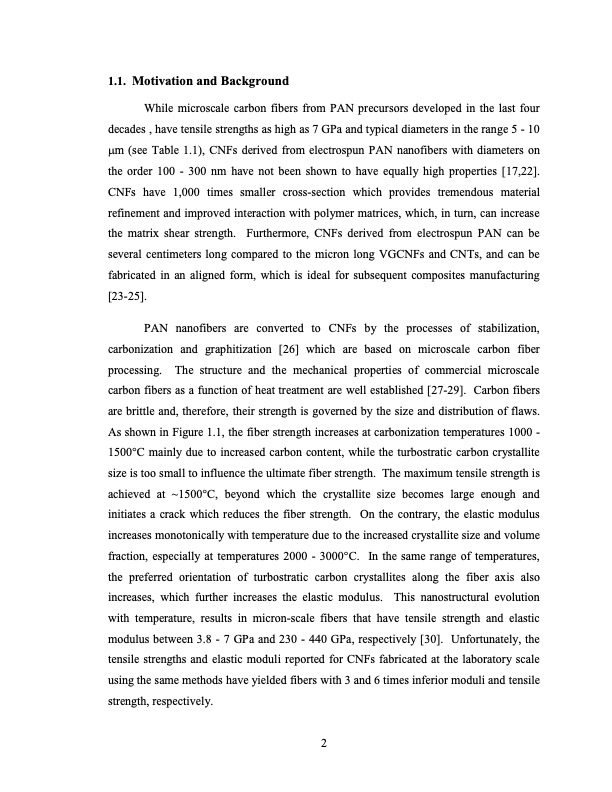
PDF Publication Title:
Text from PDF Page: 009
1.1. Motivation and Background While microscale carbon fibers from PAN precursors developed in the last four decades , have tensile strengths as high as 7 GPa and typical diameters in the range 5 - 10 m (see Table 1.1), CNFs derived from electrospun PAN nanofibers with diameters on the order 100 - 300 nm have not been shown to have equally high properties [17,22]. CNFs have 1,000 times smaller cross-section which provides tremendous material refinement and improved interaction with polymer matrices, which, in turn, can increase the matrix shear strength. Furthermore, CNFs derived from electrospun PAN can be several centimeters long compared to the micron long VGCNFs and CNTs, and can be fabricated in an aligned form, which is ideal for subsequent composites manufacturing [23-25]. PAN nanofibers are converted to CNFs by the processes of stabilization, carbonization and graphitization [26] which are based on microscale carbon fiber processing. The structure and the mechanical properties of commercial microscale carbon fibers as a function of heat treatment are well established [27-29]. Carbon fibers are brittle and, therefore, their strength is governed by the size and distribution of flaws. As shown in Figure 1.1, the fiber strength increases at carbonization temperatures 1000 - 1500°C mainly due to increased carbon content, while the turbostratic carbon crystallite size is too small to influence the ultimate fiber strength. The maximum tensile strength is achieved at ~1500°C, beyond which the crystallite size becomes large enough and initiates a crack which reduces the fiber strength. On the contrary, the elastic modulus increases monotonically with temperature due to the increased crystallite size and volume fraction, especially at temperatures 2000 - 3000°C. In the same range of temperatures, the preferred orientation of turbostratic carbon crystallites along the fiber axis also increases, which further increases the elastic modulus. This nanostructural evolution with temperature, results in micron-scale fibers that have tensile strength and elastic modulus between 3.8 - 7 GPa and 230 - 440 GPa, respectively [30]. Unfortunately, the tensile strengths and elastic moduli reported for CNFs fabricated at the laboratory scale using the same methods have yielded fibers with 3 and 6 times inferior moduli and tensile strength, respectively. 2PDF Image | HIGH STRENGTH CARBON NANOFIBERS DERIVED FROM ELECTROSPUN POLYACRYLONITRILE

PDF Search Title:
HIGH STRENGTH CARBON NANOFIBERS DERIVED FROM ELECTROSPUN POLYACRYLONITRILEOriginal File Name Searched:
4835609.pdfDIY PDF Search: Google It | Yahoo | Bing
Sulfur Deposition on Carbon Nanofibers using Supercritical CO2 Sulfur Deposition on Carbon Nanofibers using Supercritical CO2. Gamma sulfur also known as mother of pearl sulfur and nacreous sulfur... More Info
CO2 Organic Rankine Cycle Experimenter Platform The supercritical CO2 phase change system is both a heat pump and organic rankine cycle which can be used for those purposes and as a supercritical extractor for advanced subcritical and supercritical extraction technology. Uses include producing nanoparticles, precious metal CO2 extraction, lithium battery recycling, and other applications... More Info
| CONTACT TEL: 608-238-6001 Email: greg@infinityturbine.com | RSS | AMP |